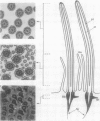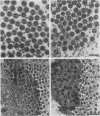Abstract
A reproducible technique, utilising a graphics tablet and a personal computer for measuring ciliary orientation from electron micrographs of ciliated epithelium, was assessed. Ciliary deviation was measured in 47 normal subjects (mean ciliary deviation +/- 1 SD was 14.6 (3.3 degrees)), in eight patients with bronchiectasis and normal ciliary function (15.1 (6.5 degrees], and in seven patients with primary ciliary dyskinesia (38.7 (7.8 degrees); significantly greater than the first two groups). Measurements of ciliary deviation at the tip, base, and basal feet showed very little variation along the ciliary shaft in all three groups, suggesting that valid measurements of ciliary deviation can be made at any level of the cilium. Mean ciliary deviation in normal subjects was always less than 30 degrees; all patients with a mean ciliary deviation of greater than 30 degrees had recurrent respiratory tract disease. Four of seven patients with primary ciliary dyskinesia had ciliary disorientation; in one this was the only defect. Measurements of inter- and intraobserver variability using this method showed a maximum difference between observations of 4.1 degrees. It is suggested that ciliary orientation should be measured in patients suspected of having defective ciliary function or structure, or both.
Full text
PDF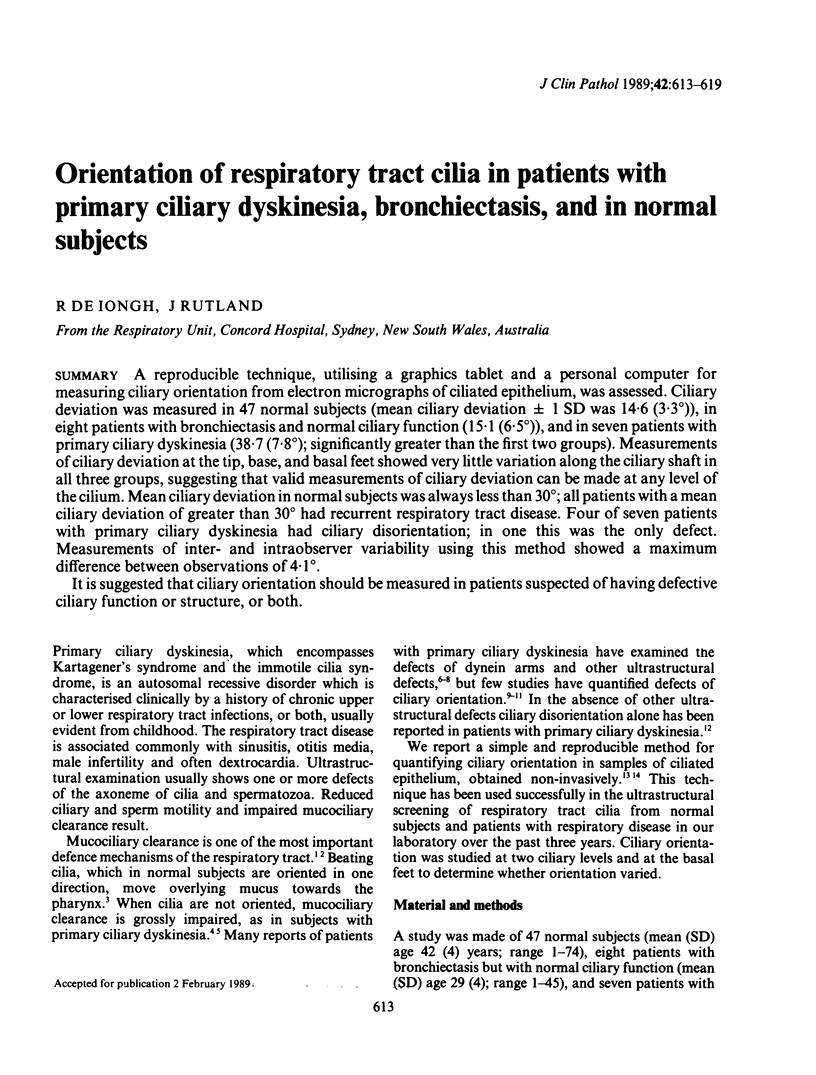
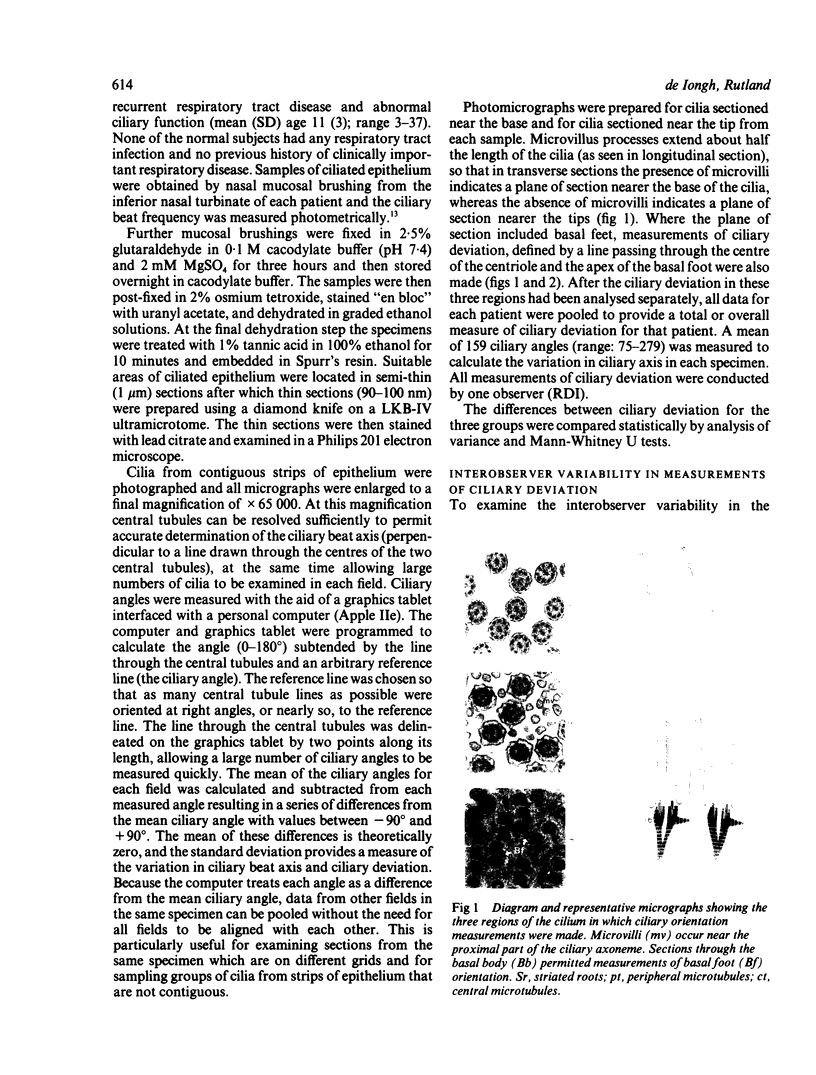
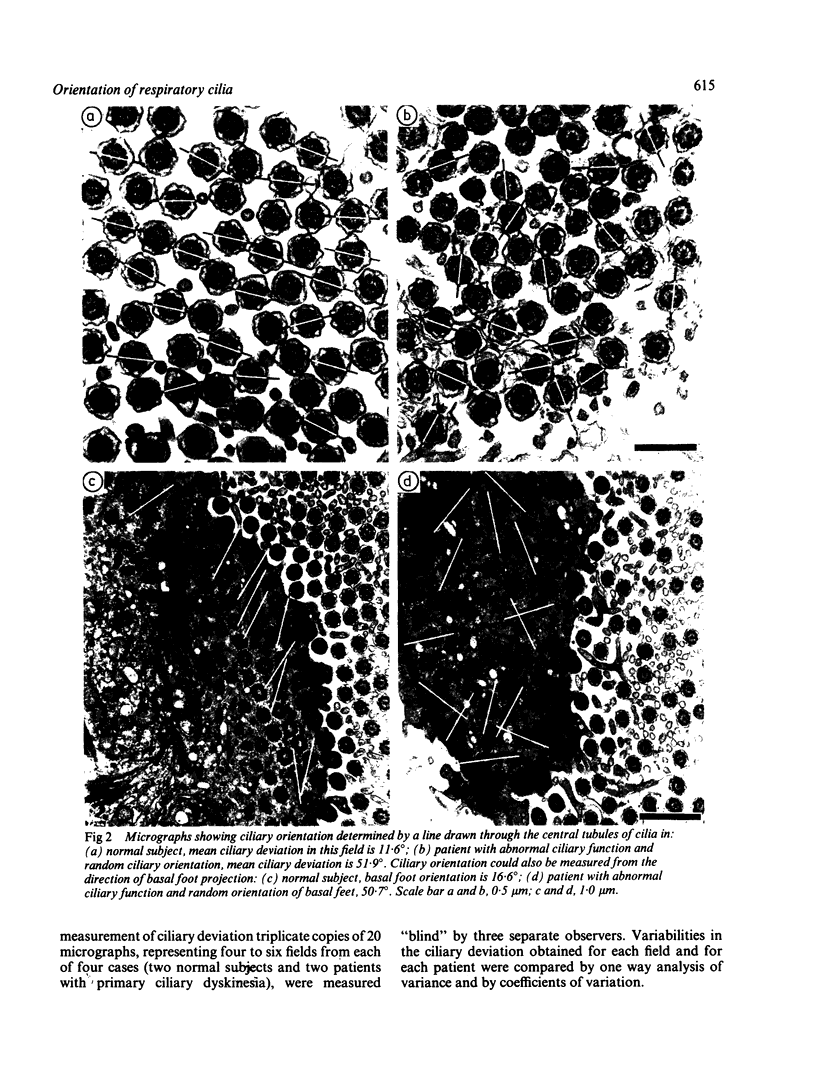

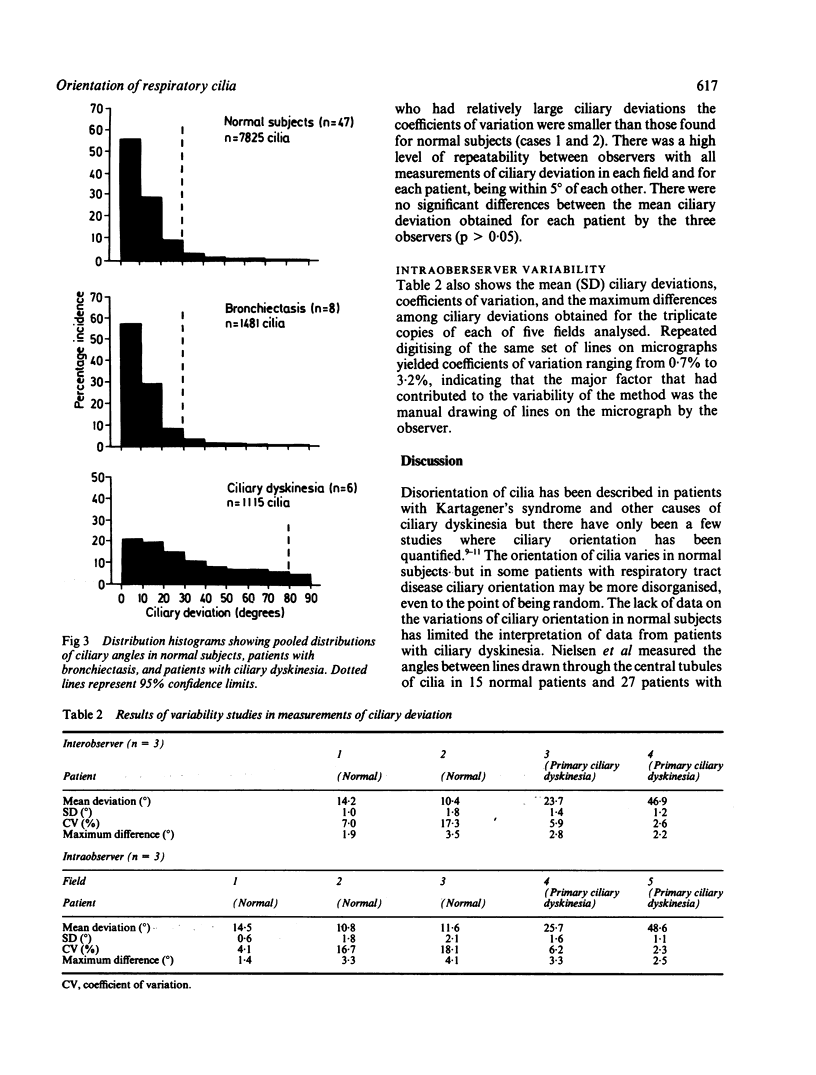

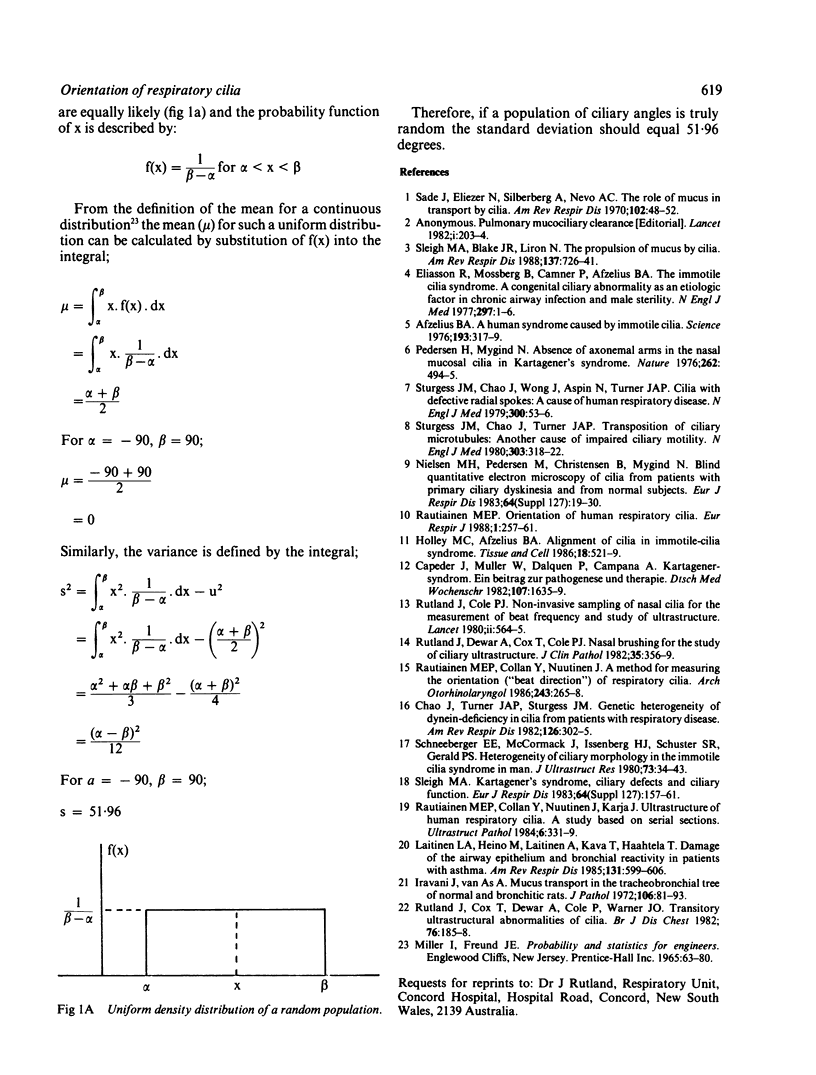
Images in this article
Selected References
These references are in PubMed. This may not be the complete list of references from this article.
- Afzelius B. A. A human syndrome caused by immotile cilia. Science. 1976 Jul 23;193(4250):317–319. doi: 10.1126/science.1084576. [DOI] [PubMed] [Google Scholar]
- Capeder J., Müller W., Dalquen P., Campana A. Kartagener-Syndrom. Ein Beitrag zur Pathogenese und Therapie. Dtsch Med Wochenschr. 1982 Oct 29;107(43):1635–1639. doi: 10.1055/s-2008-1070179. [DOI] [PubMed] [Google Scholar]
- Chao J., Turner J. A., Sturgess J. M. Genetic heterogeneity of dynein-deficiency in cilia from patients with respiratory disease. Am Rev Respir Dis. 1982 Aug;126(2):302–305. doi: 10.1164/arrd.1982.126.2.302. [DOI] [PubMed] [Google Scholar]
- Eliasson R., Mossberg B., Camner P., Afzelius B. A. The immotile-cilia syndrome. A congenital ciliary abnormality as an etiologic factor in chronic airway infections and male sterility. N Engl J Med. 1977 Jul 7;297(1):1–6. doi: 10.1056/NEJM197707072970101. [DOI] [PubMed] [Google Scholar]
- Eliezer N., Sadé J., Silberberg A., Nevo A. C. The role of mucus in transport by cilia. Am Rev Respir Dis. 1970 Jul;102(1):48–52. doi: 10.1164/arrd.1970.102.1.48. [DOI] [PubMed] [Google Scholar]
- Holley M. C., Afzelius B. A. Alignment of cilia in immotile-cilia syndrome. Tissue Cell. 1986;18(4):521–529. doi: 10.1016/0040-8166(86)90018-2. [DOI] [PubMed] [Google Scholar]
- Iravani J., As van A. Mucus transport in the tracheobronchial tree of normal and bronchitic rats. J Pathol. 1972 Feb;106(2):81–93. doi: 10.1002/path.1711060204. [DOI] [PubMed] [Google Scholar]
- Laitinen L. A., Heino M., Laitinen A., Kava T., Haahtela T. Damage of the airway epithelium and bronchial reactivity in patients with asthma. Am Rev Respir Dis. 1985 Apr;131(4):599–606. doi: 10.1164/arrd.1985.131.4.599. [DOI] [PubMed] [Google Scholar]
- Nielsen M. H., Pedersen M., Christensen B., Mygind N. Blind quantitative electron microscopy of cilia from patients with primary ciliary dyskinesia and from normal subjects. Eur J Respir Dis Suppl. 1983;127:19–30. [PubMed] [Google Scholar]
- Pedersen H., Mygind N. Absence of axonemal arms in nasal mucosa cilia in Kartagener's syndrome. Nature. 1976 Aug 5;262(5568):494–495. doi: 10.1038/262494a0. [DOI] [PubMed] [Google Scholar]
- Rautiainen M. E. Orientation of human respiratory cilia. Eur Respir J. 1988 Mar;1(3):257–261. [PubMed] [Google Scholar]
- Rautiainen M., Collan Y., Nuutinen J. A method for measuring the orientation ("beat direction") of respiratory cilia. Arch Otorhinolaryngol. 1986;243(4):265–268. doi: 10.1007/BF00464443. [DOI] [PubMed] [Google Scholar]
- Rautiainen M., Collan Y., Nuutinen J., Kärjä J. Ultrastructure of human respiratory cilia: a study based on serial sections. Ultrastruct Pathol. 1984;6(4):331–339. doi: 10.3109/01913128409018591. [DOI] [PubMed] [Google Scholar]
- Rutland J., Cole P. J. Non-invasive sampling of nasal cilia for measurement of beat frequency and study of ultrastructure. Lancet. 1980 Sep 13;2(8194):564–565. doi: 10.1016/s0140-6736(80)91995-9. [DOI] [PubMed] [Google Scholar]
- Rutland J., Cox T., Dewar A., Cole P., Warner J. O. Transitory ultrastructural abnormalities of cilia. Br J Dis Chest. 1982 Apr;76(2):185–188. [PubMed] [Google Scholar]
- Sleigh M. A., Blake J. R., Liron N. The propulsion of mucus by cilia. Am Rev Respir Dis. 1988 Mar;137(3):726–741. doi: 10.1164/ajrccm/137.3.726. [DOI] [PubMed] [Google Scholar]
- Sleigh M. A. Kartagener's syndrome, ciliary defects and ciliary function. Eur J Respir Dis Suppl. 1983;127:157–161. [PubMed] [Google Scholar]
- Sturgess J. M., Chao J., Turner J. A. Transposition of ciliary microtubules: another cause of impaired ciliary motility. N Engl J Med. 1980 Aug 7;303(6):318–322. doi: 10.1056/NEJM198008073030606. [DOI] [PubMed] [Google Scholar]
- Sturgess J. M., Chao J., Wong J., Aspin N., Turner J. A. Cilia with defective radial spokes: a cause of human respiratory disease. N Engl J Med. 1979 Jan 11;300(2):53–56. doi: 10.1056/NEJM197901113000201. [DOI] [PubMed] [Google Scholar]



